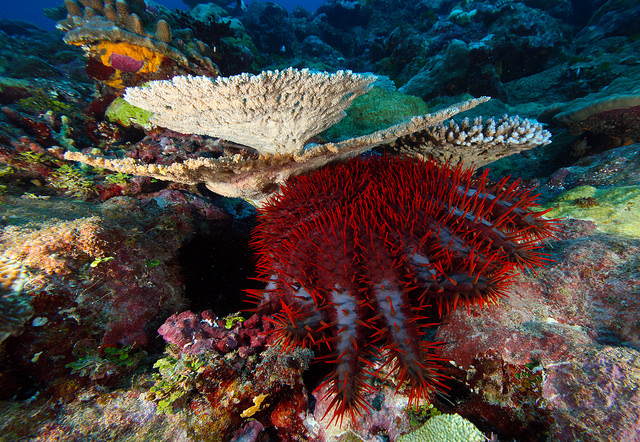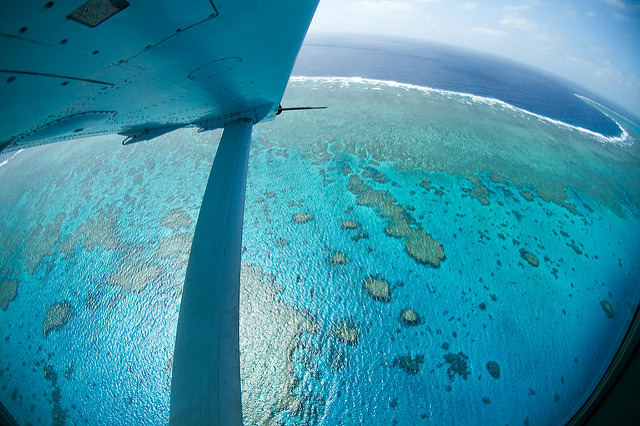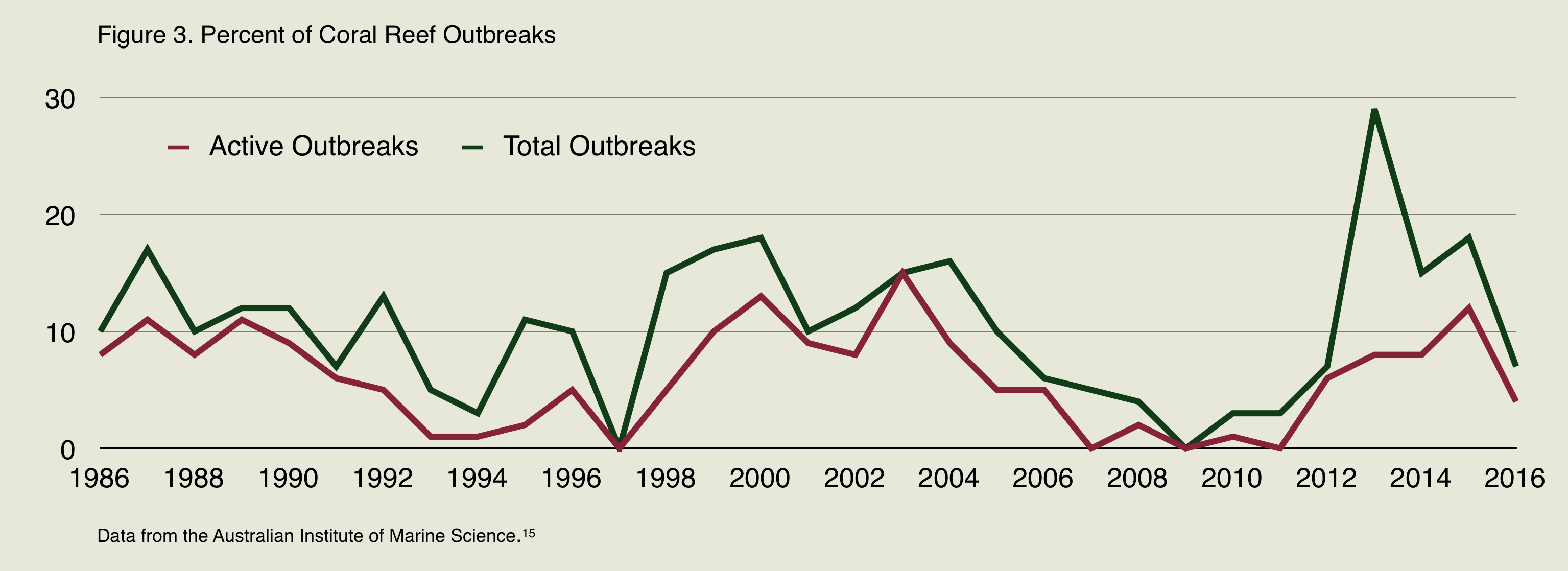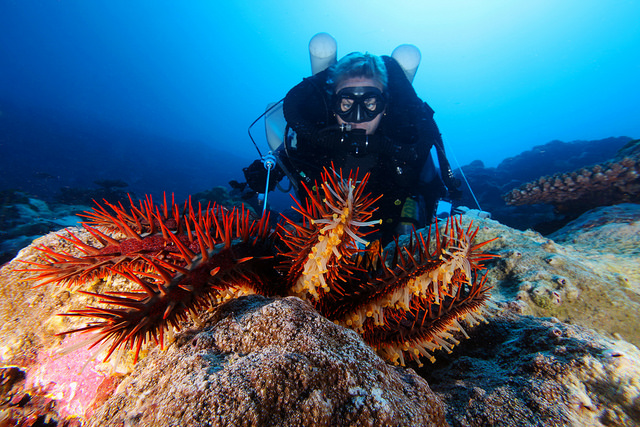Invasive Species
1.6 How the Great Barrier Reed is Being Affected by the Crown-Of-Thorns Starfish
Kaitlyn E. Kelly
The Great Barrier Reef, one of the seven natural wonders of the world, is teeming with species of tropical fish and coral. However, now the reef is under attack by outbreaks of the crown-of-thorns starfish who prey upon the coral that inhabit it. Can reefs recover from this devastative invasive species?

The Great Barrier Reef, covering about 347,058 square kilometers (134,000 square miles) along the coast of Queensland, Australia, is home to more than 1,500 species of tropical fish and 400 species of coral.3 This wonder of the natural world is teeming with so much life that in 1981 it was named a United Nations Educational, Scientific and Cultural Organization (UNESCO) World Heritage site.3,5 Unfortunately, due to various environmental factors that have severely impacted the reef, it is on the list of World Heritage in Danger.3,5 Nearly half of the reef’s coral died between 1985 and 2012, and approximately 42% of this decline can be attributed to outbreaks of the crown-of-thorns starfish (COTS).3,4,6,8

The crown-of-thorns starfish, or Acanthaster planci, is a large echinoderm covered in thorn-like spikes that preys upon coral.2,9 While it is native to the Indo-Pacific region, the starfish has been described as invasive because of its dense populations, and the devastation it is causing to the Great Barrier Reef.3,10 This predator prefers to feed on fast-growing coral, but will also feed on boulder coral, which are huge coral formations that take hundreds of years to grow.2 Coral are digested outside of the starfishes bodies, as they coil themselves around their prey and eject their stomachs into the coral.4
Scientists have argued over the environmental triggers that have contributed to the outbreaks of these starfish. The two main hypotheses have both emphasized the importance of anthropogenic impact.1,3,5 These are the predator removal hypothesis and the terrestrial runoff hypothesis.10 The predator removal hypothesis states that the population of crown-of-thorns starfish has increased due to the overfishing of its predators.1,10 The proposed solution is a commercial fishing ban that establishes “no-take” regions.1,4 This solution is thought to work in a trickle-down manner.4 The large fish protected by these bans prey on smaller fish, which prey on the invertebrates that eat the starfish larvae.4 If the amount of large fish is decreased due to commercial fishing, the small fish population will grow and the number of larvae eating invertebrates will go down drastically, resulting in more crown-of-thorns starfish.4 Researchers have found that there were as many as seven times fewer outbreaks of crown-of-thorns starfish in “no-take” regions than in areas without commercial fishing bans.4
The terrestrial runoff hypothesis proposes that increases in crown-of-thorns populations can be attributed to an increased amount of terrestrial nutrients in the water from major rainfall or runoff events.3,5,10 Excessive nutrients allow for denser phytoplankton populations which allow for better larval survival, yielding more adult crown-of-thorns starfish.5,10 Both hypotheses provide insight to the potential causes of outbreaks, however testing of these hypotheses has been hampered by the inability to investigate the spatiotemporal distribution of crown-of-thorns larvae, because they resemble other planktotrophic echinoderm larvae.8 However, a group of researchers were able to develop a genetic marker and tested it on 48 plankton samples collected during the 2014 spawning season in the northern Great Barrier Reef. The genetic marker was verified by polymerase chain reaction (PCR) amplification of single larva.8 Most of the collected samples were positive for crown-of-thorns larvae and these were detected up to 100 km (62 miles) south of current outbreaks at the time of testing.8 These findings highlight the potential for rapid expansion of outbreaks and the development of a genetic marker will allow for better detection of these outbreaks.8

Fortunately, reefs can regain their coral cover. However the process is gradual, taking between 10 to 20 years.3 This is only possible if the crown-of-thorns populations are kept under control. In the past, this responsibility has been solely placed on divers.2 Divers have been expected to physically remove these predators from their habitat or inject them with a lethal chemical.2 Now divers will have the assistance of the COTSbot, which is an autonomous vehicle that is programmed to patrol the Great Barrier Reef and kill via lethal injection any crown-of-thorns starfish it detects (Figure 5).6 The COTSbot follows a preprogrammed path and scans for the crown-of-thorns starfish which can be distinguished by their purplish color and arm/thorn shapes.6 The bot can operate at night when starfish are more active and swimming is prohibited.6 It can also operate during stormy weather and high currents, and is programmed to recognize certain positions these starfish take when hiding.6 When a starfish is spotted, it lowers its arm and injects the starfish with 10 milliliters of poisonous bile salts which effectively digests the echinoderm from the inside.6 Bile salts have recently replaced sodium bisulfate as the toxin of choice.7 After researching different options, scientists concluded that along with 12 g l−1 of Oxgall solution, injections of 10 mL of 8 g l−1 Bile Salts No. 3 is the most rapid and effective way to kill off these predators.7 The starfish will die within 24 hours of injection which prevents opportunities for separation and regeneration.6,7

Efforts to reduce and control the population of crown-of-thorns starfish are vital to the survival of Great Barrier Reef. The Great Barrier Reef is a UNESCO World Heritage Site and vital to Australia’s tourism industry.3,5 Efforts thus far have been somewhat successful, however more work and research needs to be done to ensure the reef has the capacity to regrow its lost corals.
Figure 5. Coral reefs are diverse ecosystems with many species of coral. The Crown of Thorns Starfish is a threat to all of these populations, as they are unable to escape its grasp. Photographs by Bernard Dupont, 2009, FlickrCommons. CC BY-SA 2.0. Tim Sheerman-Chase, 2013, FlickrCommons. CC BY 2.0. Robert Linsdell, 2012, FlickrCommons. CC BY 2.0.
References:
- Ewing, T., (1988). Thorny problem as Australia’s coastline faces invasion. Nature, 333(6172):387.
- Fears, D. (2015, November 16). Scientists say a plague of sea stars is devastating Pacific coral reefs. The Washington Post. Retrieved from https://www.washingtonpost.com/news/energy-environment/wp/2015/11/16/scientists-say-crown-of-thorns-sea-stars-are-crucifying-pacific-coral-reefs/.
- Gruber, K. (2015, March 23). The Great Barrier Reef is under siege. The Washington Post.
- Hadhazy, A. (2008, July 21). Fishing bans may save corals from killer starfish. Scientific American. Retrieved from http://www.scientificamerican.com/article/killer-starfish/
- Handwerk, B. (2013, June 9). Great Barrier Reef: world heritage in danger?. National Geographic.
- Platt, J.R., (2016, January 1). A Starfish-Killing, Artificially Intelligent Robot Is Set to Patrol the Great Barrier Reef. Scientific American. Retrieved from https://www.scientificamerican.com/article/a-starfish-killing-artificially-intelligent-robot-is-set-to-patrol-the-great-barrier-reef/
- Rivera-Posada, J., et al., (2014). Bile salts and the single-shot lethal injection method for killing crown-of-thorns sea stars (Acanthaster planci). Ocean & Coastal Management, 102 Part A:383-390.
- Uthicke, S., et al. (2015). Outbreak of coral-eating Crown-of-Thorns creates continuous cloud of larvae over 320km of the Great Barrier Reef. Scientific Reports, 5:16885.
- Vine, P.J., (1970). Field and Laboratory Observations of the Crown-of-Thorns Starfish, Acanthaster planci: Densities of Acanthaster planci in the Pacific Ocean. Nature, 228(5269):341-342.
- Wooldridge, S.A., & Brodie, J.E. (2015). Environmental triggers for primary outbreaks of crown-of-thorns starfish on the Great Barrier Reef, Australia. Marine Pollution Bulletin, 101(2):805-815.
Figures:
- Dupont, Bernard. (2009). [Photograph of Pink Gorgnian coral]. Retrieved from FlickrCommons. CC BY-SA 2.0.
- Lindsdell, Robert. (2012). [Photograph or Agincourt Reef in Great Barrier Reef]. Retrieved from FlickrCommons. CC BY 2.0.
- McFall, Greg, National Oceanic and Atmospheric Administration. (2014). [Photograph of corn-of-thorns starfish]. Retrieved from FlickrCommons. Public Domain.
- McFall, Greg, National Oceanic and Atmospheric Administration. (2014). [Photograph of diver and starfish]. Retrieved from FlickrCommons. Public Domain.
- Monitoring Crown-of-Thorns Starfish on the Great Barrier Reef. Australian Institute of Marine Science.
- Sheerman-Chase, Tim. (2013). [Photograph of Acropora coral]. Retrieved from FlickrCommons. CC BY 2.0.
- Tchami. (2014) [Photograph of Great Barrier Reef from above]. Retrieved from FlickrCommons. CC BY-SA 2.0.
